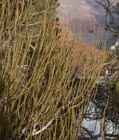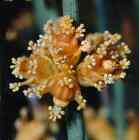Ephedra viridis
Coville 1893
Common names
Green ephedra (Stevenson 1993), mountain joint fir (Jaeger 1969), Mormon tea, Brigham tea (Elmore and Janish 1976).
Taxonomic notes
Syn: Ephedra nevadensis S. Watson subvar. pluribracteata Palmer ex Stapf; E. nevadensis S. Watson var. viridis (Coville) M.E. Jones (Stevenson 1993). Type specimen "collected June 12, 1892, near Crystal Spring, Coso Mountains, Inyo County, California, by Frederick V. Coville" (Coville 1893).
Description
"Shrubs erect, 0.5-1 m. Bark gray, cracked and irregularly fissured. Branches alternate or whorled, rigid, angle of divergence about 30°. Twigs bright green to yellow-green, becoming yellow with age, not viscid, ridges between longitudinal grooves barely papillate, smooth; internodes 1-5 cm. Terminal buds conic, 1-2 mm, apex obtuse. Leaves opposite, 2-5 mm, connate to 1/2-3/4 their length, not photosynthetic; bases thickened, brown, persistent, becoming hard, enlarged, and black; apex setaceous. Pollen cones 2-several at node, obovoid, 5-7 mm, sessile; bracts opposite, 6-10 pairs, light yellow and slightly reddened, ovate, 2-4 × 2-3 mm, membranous, slightly connate at base; bracteoles slightly exceeding bracts; sporangiophores 2-4 mm, 1/4-1/2 exserted, with 5-8 sessile to nearly sessile microsporangia. Seed cones 2-several at node, obovoid, 6-10 mm, sessile or on short, scaly peduncles; bracts opposite, 4-8 pairs, ovate, 4-7 × 2-4 mm, membranous or papery, with yellow center and base, margins entire. Seeds 2, ellipsoid, 5-8 × 2-4 mm, light brown to brown, smooth. 2n = 28. ... Coning spring" (Stevenson 1993).
The paired leaves/bracts at darkened, thickened nodes serve to distinguish this species from other North American ephedras. Stevenson (1993) provides this Key to the North American species of Ephedra.
Distribution and Ecology
USA: Oregon, California, Arizona, Nevada, Utah, Wyoming, Colorado & New Mexico at 100-2500 m in piñon-juniper woodland and the Mojave desert, usually on dry rocky slopes and canyon walls (Jaeger 1969, Stevenson 1993).
Remarkable Specimens
No data as of 2023.03.03.
Ethnobotany
"The Navajo brewed the tops into a drink for use as a cough medicine. Other indians roasted the seeds, ate them whole or ground them into a meal for various uses" (Elmore and Janish 1976).
Observations
See the observations on iNaturalist, accessed 2021.12.31.
Remarks
The epithet refers to the bright green color of the twigs (Coville 1893).
Citations
Coville, F. V. 1893. Botany of the Death Valley Expedition. Contributions from the U.S. National Herbarium 4. Washington: Government Printing Office (p. 220).
See also
Species profile at Plants of the World Online, accessed 2021.12.31.



